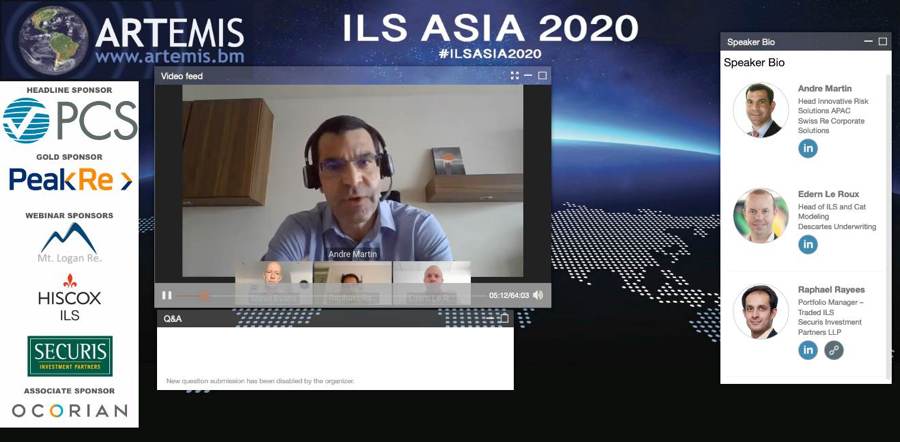Asian risk managers are warming up to parametrics: ILS Asia 2020
There’s still a very real need for greater education and awareness, but risk managers across Asia are becoming increasingly comfortable with the idea of parametric structures, according to industry experts.
 Parametric insurance continues to expand and is increasingly providing some of the world’s most vulnerable people with vital protection against a range of perils, most notably in the natural catastrophe arena.
Parametric insurance continues to expand and is increasingly providing some of the world’s most vulnerable people with vital protection against a range of perils, most notably in the natural catastrophe arena.
Much of Asia is extremely vulnerable to a wide range of natural catastrophe events and, at the same time, reports some of the lowest levels of insurance penetration on the planet.
Parametric coverages are structured to trigger when predetermined parameters have been met, such as windspeed or amount of rainfall at a specific location, and therefore do not require on-site loss assessment post-event, meaning payout is rapid, and, any uncertainty around whether the contract has been triggered is removed.
Against this backdrop, Artemis’ virtually held ILS Asia 2020 conference featured a panel on parametric risk transfer in Asia (watch the full session on-demand here), which included Andre Martin, Head of Innovative Risk Solutions APAC at Swiss Re Corporate Solutions; Edern Le Roux, Head of ILS and Cat Modelling at Descartes Underwriting; and Raphael Rayees, Portfolio Manager, Traded ILS, Securis Investment Partners.
“Parametric insurance is not that new,” said Martin, “but it’s only over the last five to ten years that it’s really moving out of this more exotic space in the insurance sector to more the mainstream side.”
In recent years, and notably in the insurance-linked securities (ILS) space, parametric trigger structures have grown in popularity and Martin told the audience that now, corporate risk managers use this type of protection as an alternative and to complement their traditional programmes.
“Now, here in Asia, I think we have our fair share of nat cat exposure, so most of the requests that we are getting at the moment is still related to earthquake and typhoon. But, I think climate change, especially the last two years, has become very real, has become very visible and painful for corporations. So, what we see now is more requests around parametric solutions for what we call the secondary perils,” said Martin.
Discussing interest for parametric solutions from buyers in the Asian region, Martin said that appetite was definitely rising.
“Risk managers are really warming up to the concept. It is still education, still awareness creation, but they are warming up. And, we see really a number of deals being executed every month and really across the whole region,” said Martin.
When considering the severity and frequency of extreme weather events and the severe lack of insurance take-up across Asia, the growth potential for parametric solutions in the region is substantial.
This was highlighted by panellist Le Roux of Descartes Underwriting, who explained that Asia is one of the firm’s key areas for development.
“Naturally catastrophes in Asia are among the most intense in the world, and there is a huge need of protection to cover these risks. Parametric is steadily growing in Asia with the increased availability and accuracy of data sources, allowing us to broaden the scope of perils covered.
“We are also seeing jumps in the development for regions with recent loss history, which are experiencing a very hard market,” said Le Roux.
Of course, to effectively structure a parametric insurance contract a certain amount of data is required and, at Descartes, data is key.
Le Roux told the audience that while in Asia there is access to satellite data relatively easily, it is still more difficult to obtain windspeed data, for example, when compared with more developed markets like the U.S.
As noted early on in the discussion by Martin, greater education and awareness around parametrics is still needed across much of Asia. With this in mind, panellist Rayees offered some thoughts on the investment case for parametric structured risk and how his firm approaches these types of transactions.
“For us, a parametric investment, and I presume for the rest of the market, it’s in scope so we can consider it when we’re getting some sort of excess return over a statistical measure of risk,” said Rayees.
Adding, “There are quite a few advantages, especially in a year like 2020. One is the moral hazard. For anyone following the ILS landscape, and specifically in Florida in the U.S., moral hazard is a very, very big risk in the reinsurance industry and for us in ILS, but with parametric structures you can get away from that. We can really focus on a very narrow risk, limited scope, so you can really try and draft a return from a pure form of the risk.
“The secondary risks are minimal. But, what I mean by that is there is less of a concern as to how the actual hazard effects the loss. You are less worried about that, you would have seen that in 2017 in Florida where areas with very low wind speed suffered high losses. So, again, with parametrics you’re less concerned about that.
“What’s most interesting this year is you can go back to the pure hazard. A lot of people in the market this year are concerned about inflation coming from the lockdown, across the globe really. And, again, with parametric structures you don’t have to be overly concerned with that really.”
You can watch the full parametric risk transfer session from our virtual conference on-demand here.
Asian risk managers are warming up to parametrics: ILS Asia 2020 was published by: www.Artemis.bm
Our catastrophe bond deal directory
Sign up for our free weekly email newsletter here.
Original Article Posted at : https://www.artemis.bm/news/asian-risk-managers-are-warming-up-to-parametrics-ils-asia-2020/
